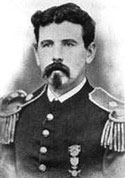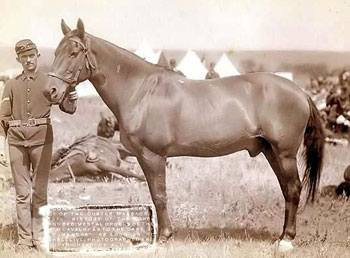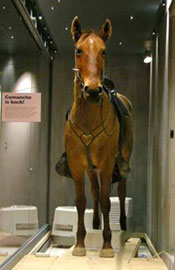Written by J. Drake
A horse of the late-19th Century,
Comanche's life was some-what normal until that fate-ful day that
would cause him to be remembered for centuries to come. It wasn't
of his choosing, but Comanche found himself in the middle of one
of the bloodiest battles of U.S. history. The battle that would
become known as "Custer's Last Stand" would change Comanche's
life forever.
 Comanche
was a 15 hand buckskin, also called a "claybank," gelding.
It is said that he was part mustang and part Morgan, although he
may have been purly of Mustang decent. He was originally captured
on the southern plains and brought to a remount station in St. Louis,
Missouri where he was then purchased by the U.S. Army for $90. He
was then shipped to Fort Leavenworth where he was chosen to be one
of the forty-one horses LT Tom Custer would ship to Ellis Station,
where the 7th Cavalry was encamped. In May, 1868, Comanche arrived
at the camp and caught the eye of Captain Myles Walter Keogh. Keogh,
an Irish soldier whose thirst for adventure led him to fighting
in the American Civil War and then the Indian Wars of the 1870's,
was looking for a horse to replace a mount he had just lost during
a skirmish and something about Comanche called out to him and he
ordered Comanche to be his mount. Comanche
was a 15 hand buckskin, also called a "claybank," gelding.
It is said that he was part mustang and part Morgan, although he
may have been purly of Mustang decent. He was originally captured
on the southern plains and brought to a remount station in St. Louis,
Missouri where he was then purchased by the U.S. Army for $90. He
was then shipped to Fort Leavenworth where he was chosen to be one
of the forty-one horses LT Tom Custer would ship to Ellis Station,
where the 7th Cavalry was encamped. In May, 1868, Comanche arrived
at the camp and caught the eye of Captain Myles Walter Keogh. Keogh,
an Irish soldier whose thirst for adventure led him to fighting
in the American Civil War and then the Indian Wars of the 1870's,
was looking for a horse to replace a mount he had just lost during
a skirmish and something about Comanche called out to him and he
ordered Comanche to be his mount. 
Comanche and Keogh (pictured at
right) went into battle on several occassions, surviving with only
a few scars to show for it. However, on June 25, 1876, the two would
meet up with fate when Keogh rode Comanche into the valley of the
Little Big Horn and the battle that would be called "Custer's
Last Stand." History tells us that there were no survivors
left alive after the Native Americans left the field vistoriously.
There was one, however, and that was Comanche.
Two days after the battle took
place, members of the besieged group of soldiers from the Reno Hill
entrenchment sadly explored the scene of "sickening, ghastly
horror" on Custer Hill. They walked among the bodies, identifying
the dead when someone noticed a horse's whinney. When they looked
up, a horse was spotted down by the river struggling to get to its
feet. The horse was immediately recognized at Keogh's mount, Comanche,
from his unique color which was now matted in dried blood. Comanche
was coaxed to his feet and ordered to be taken care of. He was taken
to Fort Lincoln where he was put under the care of Dr. Stein who
nursed his many (at least seven bullets) wounds. It is said that
it took Comanche over a year to regain his health.

Comanche in an artisticly recreated scene of Little Big Horn.
The war-hero, that was Comanche,
was never to be ridden or go into battle again. COL Sturgis issued
a General Order that stated "...a special and comfortable stall
is fitted up for him, and he will not be ridden by any person whatsoever
under any circumstances, nor will he be put to any kind of work."
For the remainder of his life, he served as a mascot of the Seventh
Cavalry, used in parades, draped in mourning and led by a mounted
trooper of Troop I. Under the watchful eye of Gustave Korn, the
7th's farrier, Comanche lived another fifteen years. Korn and Comanche
also developed a strong bond for eachother and it has been said
that Comanche would follow Korn all over the Post as he had the
freedom to go about as he pleased. 
Comanche's health started to fade
and on November 7, 1891, the valiant war horse passed away. In an
interesting side-note, Korn was killed at the battle of Wounded
Knee in 1890, afterwards, Comanche's health began to deteriorate
as he mourned the loss of his caretaker of many years. The men of
the Seventh Cavalry were so heartbroken by the loss of their beloved
Camanche, that one of them suggested his body be mounted to be preserved
forever and kept by the unit. Professor Dyche, of the University
of Kansas, was summoned to do the task. He was to be paid $400 to
preserve Comanche but when payment was not made, Dyche kept Comanche
in lieu of payment. Comanche (pictured at right) now still stands
today at the University of Kansas, forever remembered as the sole
military survivor of the Battle of Little Big Horn.
Captured somewhere on the southern plains
Joined the 7th Cavalry on April 3, 1868
Died: November 7, 1891
Age: Lived over 25 years.
Height: 15 hands
Weight: 925 pounds
Color: Buckskin
Remarks: excused from all duties per G.O. No. 7 April 10, 1878.
Ridden by CPT Keogh in Battle of Little Bighorn River, M.T. June
25, 1876
|

